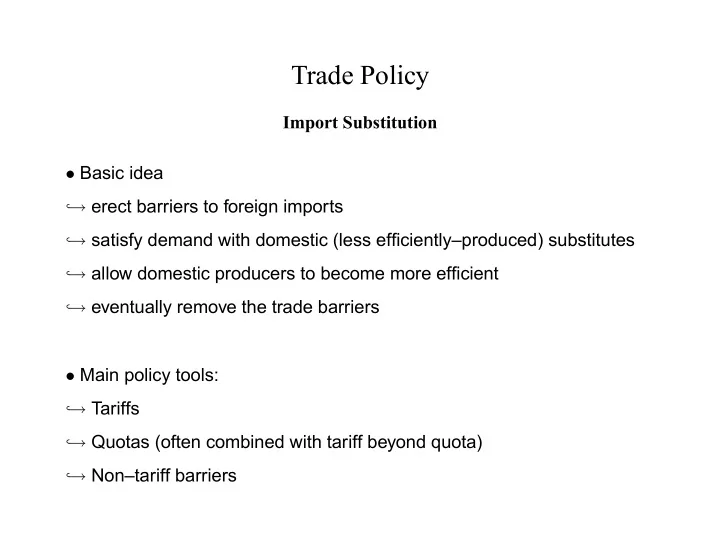

Trade Policy Import Substitution • Basic idea → erect barriers to foreign imports , → satisfy demand with domestic (less ef Þ ciently–produced) substitutes , → allow domestic producers to become more ef Þ cient , → eventually remove the trade barriers , • Main policy tools: → Tariffs , → Quotas (often combined with tariff beyond quota) , → Non–tariff barriers ,
The Impact of Import Barriers (Small Open Economy) ² Implicit assumptions: ! competitive markets , , ! all the parties get equal weight in the welfare analysis ! world price, P ¤ , is independent of domestic policy , ² Static Welfare Consequences Domestic consumers’ loss = P ¤ BDP t Domestic producers’ loss = P ¤ ACP t Government revenue gain = CDEF Net deadweight loss = ACE + BDF
Price Domestic Supply Autarky Price P* B A Domestic Demand Quantity Imports 2.Import Sector with no Policy Intervention
Price Domestic Supply D C t P P* B A Domestic Demand Quantity Imports 3.Impact of Tariff
Potential Dynamic Bene Þ ts → from protecting domestic “infant” industry , • “Learning–by–doing” effects → cost reductions that can only be achieved through on–going production , (see Ray p. 670–672). • Spillovers to other industries → e.g. through effects on public education system , • Increasing returns to scale → DC producers often have a ÞrstÐmover advantage , → LDC producers must achieve an efÞcient scale to compete ,
Price Domestic Supply p t p* Domestic Demand B A Quantity 7.Short Term Increase in Domestic Production due to Tariff
Price Internationally Competitive p t p* Domestic Demand Quantity 8.Long Term – after cost reductions due to learning
Average Cost, Price b p* Average Cost a Curve Quantity f Q d Q 9.Increasing Returns and Protection
!"#$%&'( )*+, +,& -'.#"+ /0$(+*+0+*#1 /+"2+&34 ! !"#$%&$'#( )*+ '(,-&% &#($'(-%, '(%./&'%(&+ " !"#$%&'( #$%)"*&*&+" ,"-.&,"/ #$/*01 "22$,* 3'4 &'+"/*%"'* ! " &'#"'*&+"/ *$ &'#., #$/*/ 4")"'4 $' .0*&%3*" ,"%$+30 $2 *,34" !3,,&",/ ! 567 $'#" ),$*"#*"48 ,"%$+30 $2 !3,,&",/ !"#$%"/ 4&29#.0* : ;<1 = " 4$%"/*&# ),$4.#",/ %31 <3+" 0&**0" &'#"'*&+" *$ &'+"/* ! # .0*&%3*"01 4")"'4/ $' &"%,'0'1'$+ $2 *<" ($+",'%"'*>/ /*,3*"(1
² Detrimental impact on primary exports due to exchange rate distortions , ! widespread IS reduces demand for foreign currency , ! domestic currency becomes overvalued , ! foreign prices of domestic exports rise and demand for them contracts ! tends to hurt primary goods producing sectors (e.g. agriculture), ,
Example: Import Substitution in Brazil (Ray, pp. 674–6) , ! large internal market ² 1949–1964: IS responsible for 25% of growth in demand for domestic manufacturing ! imports fell from 14% to 6% of total supply , ² 1965–74: shift towards export promotion , ! rapid export growth ² 1975–1982: return to IS, but for capital goods , ! “... created powerful domestic groups with enormous vested interests in continuation of inward–looking policies...”
!"# $%&# '(') *+%, -,.%+/ 0123/4/1/4%5 ! !"#$ %&'( )"# *#+, (-.-)- !"#$ %&'("( *# +/- 0123( ! 4)*(-( 5-)- #,+ 4"6(-7 8$ 9: ;,<*4*-(= 86+ *+ >"7- *+ 7*?@46<+ +, )-"4+ " ,.-)."<6-7 46))-#4*-( A 7*?@46<+ +, ,8+"*# ?,)-*B# 46))-#4$ .*" -C;,)+( ! " >*(D"<<,4"+*,# ,? )-(,6)4-( 76- +, 7*(+,)+-7 *#+-)#"< ;)*4-( ! ! :+),#B<$ *#E6-#4-7 ($&)%$)&*+ *!,)($-".$ /&01&*-( *>;,(-7 8$ 4)-7*+,)( F-GBG 9!HI " )-J6*)-7 +/- )->,."< ,? +)"7- 8"))*-)( "( " 4,#7*+*,# ?,) #-5 <-#7*#BG !
Export Promotion ² Basic idea , ! provide preferential treatment to exporters of manufactured goods , ! once they are established, remove this aid. ² Main policy tools used in export promotion are: , ! export subsidies , ! reduced import duties on material inputs ! preferential credit access and terms of that credit. ,
Example: Industrial and Export Policy in South Korea Period Export GNP Growth Growth 1960–71 40% 9% 1972–79 28% 10% ² export promotion–oriented industrial policies included: ! targeted infant industry protection prior to launching export drive , , ! currency undervaluation , ! tariff exemptions on and preferential access to imported inputs , ! tax breaks to suppliers of exporters , ! preferential credit access and subsidized interest rates for exporters ! direct subsidies , , ! reduced taxes faced by successful exporters , ! creation of public enterprises to “lead the way” in new industries , ! setting of export targets
The Impact of Export Subsidies , ! effective world price for producers increased to P s = (1 + s ) P ¤ Static Welfare Consequences Domestic producers’ gain = P ¤ BDP s . Domestic consumers’ loss = P ¤ ACP s . Cost of government subsidy = CDFE . Net deadweight loss = ACE + BDF .
Price Domestic Supply P* A B Autarky Price Domestic Demand Quantity Exports 10.Export Sector with no Policy Intervention
Domestic Price Supply C D P s P* B F E A Domestic Demand Quantity Exports 11.Impact of Export Subsidy
Dynamic Benefits • Allows producers to overcome credit market failures • Learning–by–doing / positive externalities • Allows producers to overcome first mover advantage Exchange Rate Effects → increase in demand for domestic currency (from foreign consumers) , → domestic currency becomes overvalued , → real export prices rise , → hurts other exporters (primary and manufacturing) ,
Recommend
More recommend